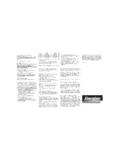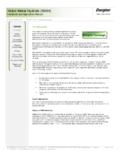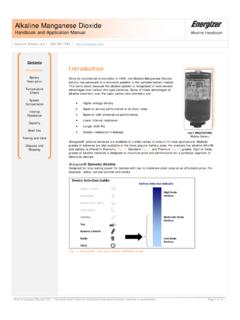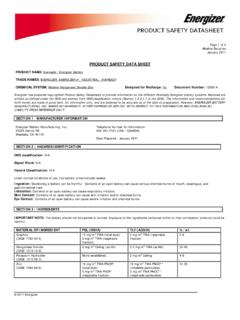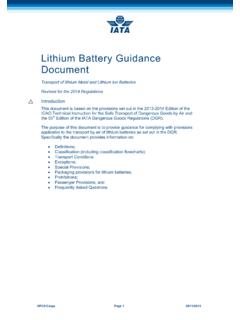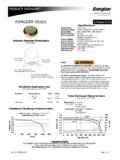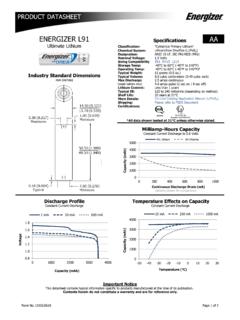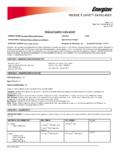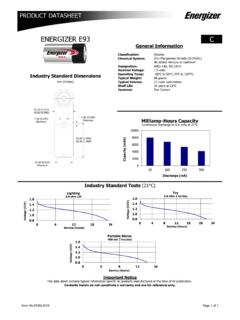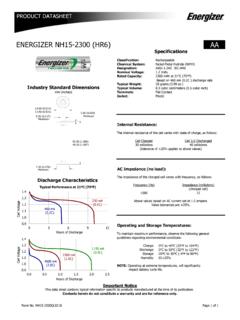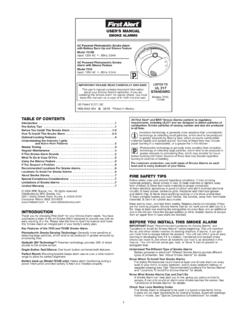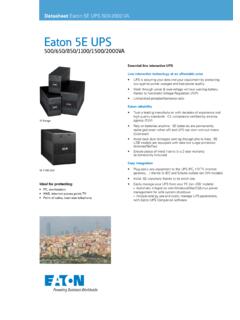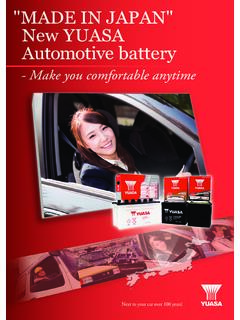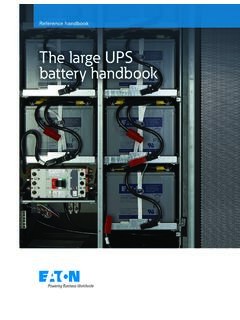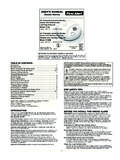Transcription of NiMH Battery Chargers
1 NiMH Battery Chargers Handbook and Application Manual Charger Handbook Energizer Brands, | 800-383-7323 | Contents Introduction Introduction Proper charging of Nickel-Metal Hydride (NiMH) batteries is important to optimize performance in any General product. Energizer offers a wide range of Chargers to meet the needs of our customers in terms of Information special features and price. The following information is intended as a guide to the features offered by the family of Energizer Chargers and their impact on Battery performance. Charge Control Many factors effect NiMH Battery performance. Some of these factors would include temperature, depth Smart Charger of discharge, charge and discharge current, exposure to overcharge and over discharge, storage Control Techniques conditions and age. The charger used can impact several of these factors and can therefore impact overall Battery performance.
2 In general, high capacity NiMH batteries are more susceptible to over- Cost to Charge charge which can reduce cycle life especially in high rate Chargers . (electricity). Summary General Information Glossary Compatibility: Charging of nickel-cadmium batteries in Energizer Chargers is not recommended. The charge rate and charge termination for our current line of Chargers is designed for higher capacity NiMH batteries. NiMH. batteries made by other manufacturers can be charged in an Energizer charger however we recommend the use of Energizer NiMH batteries. General Guidelines: - Do not attempt to charge primary (non-rechargeable) batteries ( alkaline, carbon zinc or lithium). - Do not mix Battery chemistries - Do not attempt to recharge alkaline rechargeable batteries using an Energizer charger - Do not mix fully charged and discharged batteries - Do not mix batteries of different capacities or age Calculating charge time needed: For a fully discharged NiMH Battery , an approximate charge time can be calculated using the following formula: Battery mAh capacity X 120% mA charge rate = hours of charge.
3 The Battery capacity can be found on the Energizer Battery label. The charge rate of the charger can be found on the Product Datasheet. For example, a fully discharged 2450 mAh Battery being charged at 200 mA would be fully charged in (2450 mAh X 120% 200 mA) ~15 hours. Charge Control Energizer uses three basic techniques for charge control and termination. They are continuous, timer and smart Chargers . Each of these techniques is discussed in detail in the following sections. Continuous Low Rate Charge: This type of charger relies on user management of the charge time. See Calculating Charge Time Needed in the previous section. The charger will charge the batteries as long as the charger is plugged in and the batteries are installed. Characteristics: - Typically least expensive - Slow charge is generally good for Battery cycle life - Long charge times (typically greater than 12 hours).
4 - Low charge rates used in this type to limit the effects of overcharging - No protection from charging primary (non-rechargeable) batteries - Batteries will be potentially overcharged if not properly managed by user - Reduced cycle life if not properly managed by user Timer Controlled: This type of charger will stop the main charge at a predetermined time. Some Chargers follow the main 2008 Energizer Brands, LLC. Contents herein does not constitute a warranty of service, features or performance Page 1 of 4. NiMH Battery Chargers Handbook and Application Manual Charger Handbook Energizer Brands, | 800-383-7323 | Contents charge with a trickle charge (very low charge rate) to top the batteries off or maintain their full charge. Introduction Characteristics: - Inexpensive General - A slow charge is generally good for Battery cycle life Information - Timer reduces need for user monitoring of charge time - Long charge times (typically greater than 5 hours).
5 Charge Control - Low charge rates used in this type to limit the effects of overcharging - If the timer is reset due to loss of AC power, overcharging can occur Smart Charger - No protection from charging primary (non-rechargeable) batteries Control Techniques - May over-charge or under-charge batteries based on Battery capacity vs. charger design - There is no circuitry to monitor the batteries state of charge Cost to Charge (electricity) Smart Charger: This type of charger uses a microprocessor to monitor the Battery voltage characteristics to determine Summary when it is fully charged. Typically an algorithm based on a change of voltage is used with optional backup systems using temperature or timers. Often a low rate trickle charge is used to top the Battery Glossary off or to maintain a full charge on the Battery . Characteristics: - When compared to timer controlled Chargers , smart Chargers can typically charge batteries faster without impacting performance - Relatively expensive due to advanced circuitry - Generally higher Battery temperatures associated with fast charging (less than 1 hour).
6 - Fast charging can negatively impact Battery cycle life Smart Charger Control Techniques Delta Voltage (change in voltage): The charger microprocessor continually monitors Battery voltage. When Battery voltage reaches a peak and subsequent decrease ( 15 mV), charge is terminated (fig. 1). This typically occurs at 85% to 95% of full Battery charge. Voltage During Charging Voltage During Charging NiMH Battery NiMH Battery Delta V Detection Delta V Detection Voltage Voltage Time Time (fig. 1) Delta Voltage Detection Charging Temperature: Sensors monitor Battery temperature during charge. When the batteries reach the maximum temperature limit, the charge is terminated (fig. 2). This method is typically used as a backup technique to avoid Battery overcharging and overheating. 2008 Energizer Brands, LLC. Contents herein does not constitute a warranty of service, features or performance Page 2 of 4.
7 NiMH Battery Chargers Handbook and Application Manual Charger Handbook Energizer Brands, | 800-383-7323 | Contents Temperature During Charging TemperatureNiMH. During Battery Charging NiMH Battery Introduction General Temperature Information Temperature Charge Control Smart Charger Control Techniques 0% 20% 40% 60% 80% 100% 120%. 0% 20% 40% 60% 80% 100% 120%. % Charge Cost to Charge % Charge (electricity). (fig. 2) Charging Temperature Summary Timer Control: Glossary A maximum charge time is set as a backup to avoid overcharging. Cost to Charge Batteries (electricity). The typical cost to charge a set of batteries will be less than one cent per charge. For example, the Energizer CHDC7 charger has an input rating of 7 Watts. In hours of charge, it would require ( hours X 7 Watts) 46 Watt hours or .046 kWh. If the cost of electricity is 10 cents per kWh, a charge would cost (.)
8 046 kWh X 10 cents) ~1/2 cent. Chargers that have an Energy Star rating are designed to consume minimal power when plugged in but not charging. Summary The Energizer family of Chargers offers a wide range of features to fulfill the specific needs of customers. However, there are often tradeoffs between some of these features concerning, price, charge time and optimal Battery performance. Typically optimum Battery performance will be achieved by using a relatively slow charge rate. Glossary C Rate: The current (in Amps or mA) required to charge a Battery in 1 hour up to its full rated capacity. For example, A for a 2450 mAh Battery . Capacity: A measure of how much charge a Battery can hold. This is typically stated in Amp-Hours or mAh. Cell Reversal: Reversing polarity of terminals of a cell or Battery due to over-discharge. Charge, State of (SOC): Condition in terms of the rated capacity remaining at a given point in time.
9 The SOC is typically stated as a percentage. Charging: Process of supplying electrical energy for conversion to stored chemical energy. 2008 Energizer Brands, LLC. Contents herein does not constitute a warranty of service, features or performance Page 3 of 4. NiMH Battery Chargers Handbook and Application Manual Charger Handbook Energizer Brands, | 800-383-7323 | Contents Cycle: Introduction The discharge and subsequent or proceeding charge of a rechargeable Battery such that it is restored to its original conditions. General Information Cycle Life: The number of charge / discharge cycles a rechargeable Battery can perform before capacity drops Charge Control below 60% of rated capacity. Smart Charger Deep Discharge: Control Techniques Discharge of the Battery to below the specified voltage cutoff before the Battery is replaced or recharged.
10 Cost to Charge (electricity) Depth of Discharge (DOD): The percent of rated capacity to which a cell or Battery is discharged. Summary Glossary Milliamp-Hours (mAh): Product of current (mA), multiplied by time (in hours) the circuit is closed (current flowing). NiCd: A rechargeable Nickel Cadmium Battery chemistry. In which nickel material is the cathode and cadmium is the Anode. NiMH: A rechargeable Nickel-Metal Hydride Battery chemistry. In which Nickel is the cathode and hydrogen absorbing/storing material is the anode. Overcharge: The forcing of current through a cell after all of the active material has been converted to the charged state. Over-discharged: Discharge past the point where the full capacity of the cell has been obtained. Primary Battery Detection: Primary batteries are not designed to be recharged. Many Chargers can detect a primary Battery and then terminate the charging process.
